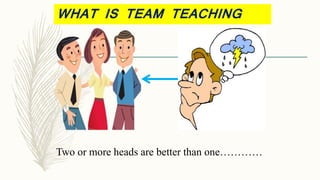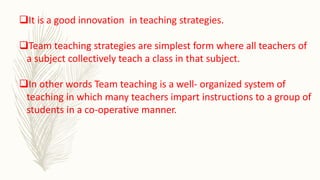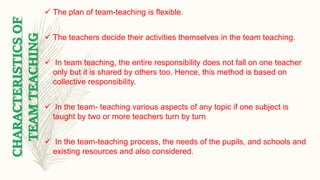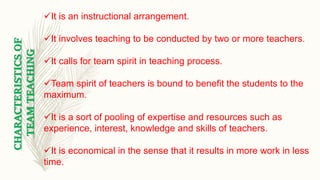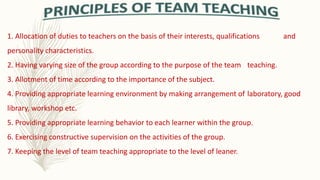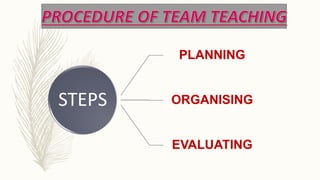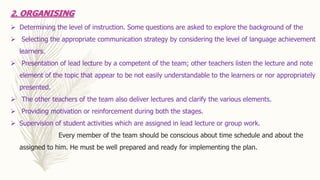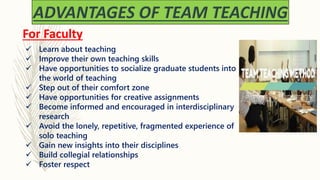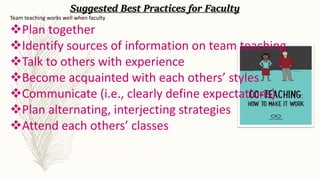Team teaching
- 2. – LAKSHMY T M – B.Ed, COMMERCE – MANGALAM COLLEGE OF EDUCATION TOPIC:-
- 3. Origin of Team Teaching Definition of Team Teaching Characteristics of Team Teaching Objectives of Team Teaching Principles of Team Teaching Types of Team Teaching Procedure of Team Teaching Advantages And Disadvantages of Team Teaching
- 4. Origin of Team Teaching Developed in 1954 in Harvard University, USA. In 1960 J EREEMAN introduced this idea in Britain. In Chicago University , FRANCIS CHASE used team teaching for effective teaching
- 5. Two or more heads are better than one………… WHAT IS TEAM TEACHING
- 6. It is a good innovation in teaching strategies. Team teaching strategies are simplest form where all teachers of a subject collectively teach a class in that subject. In other words Team teaching is a well- organized system of teaching in which many teachers impart instructions to a group of students in a co-operative manner.
- 7. The plan of the teaching methods, the time and the process are kept flexible so that the necessary changes in the program of the team teaching can be brought about according to the teaching objectives and abilities of the teachers.
- 9. J.T.SHAPLIN (1964) “Team teaching is a type of instructional organization involving teaching personnel and the students assigned to them in which two or more teachers are given responsibility, looking together, for all or a significant part of the instruction for some group students”. DAVID WARWICK “It is a form of organization in which individual teachers decide to pool resources, interest and expertise in order to device and implement a scheme of work suitable to the needs for their pupils and the facilities of their school”.
- 10. M.B.NAIK “In this teaching strategy two or more than two teachers involve to make a plan of any given subject, or subjects cooperatively, carry it out, and always evaluate its effect on the students periodically”. FRANCIS CHASE “Such an arrangement (team teaching) would allow for maximum use of the available talent; provide guidance for young and inexperienced teachers”
- 11. CHARACTERISTICSOF TEAMTEACHING The plan of team-teaching is flexible. The teachers decide their activities themselves in the team teaching. In team teaching, the entire responsibility does not fall on one teacher only but it is shared by others too. Hence, this method is based on collective responsibility. In the team- teaching various aspects of any topic if one subject is taught by two or more teachers turn by turn In the team-teaching process, the needs of the pupils, and schools and existing resources and also considered.
- 12. It is an instructional arrangement. It involves teaching to be conducted by two or more teachers. It calls for team spirit in teaching process. Team spirit of teachers is bound to benefit the students to the maximum. It is a sort of pooling of expertise and resources such as experience, interest, knowledge and skills of teachers. It is economical in the sense that it results in more work in less time. CHARACTERISTICSOF TEAMTEACHING
- 13. To improve quality of instruction. To exploit talents and expertise of teachers. To utilize resources of school. To understand importance of cooperation and group work among teachers. To develop the sense of shared responsibility. To increase flexibility in grouping and scheduling as the team teaching groups students according to their interests and aptitudes in the subject.
- 14. 1. Allocation of duties to teachers on the basis of their interests, qualifications and personality characteristics. 2. Having varying size of the group according to the purpose of the team teaching. 3. Allotment of time according to the importance of the subject. 4. Providing appropriate learning environment by making arrangement of laboratory, good library, workshop etc. 5. Providing appropriate learning behavior to each learner within the group. 6. Exercising constructive supervision on the activities of the group. 7. Keeping the level of team teaching appropriate to the level of leaner.
- 15. i. A Team From A Single Department. ii. A Team from various departments of a single institution. iii. A team from a single department of various institutions. iv. Interactive team teaching. v. Rotational format team teaching. vi. Participant – Observer team teaching. vii.Team coordination. viii.Lead and support teaching. ix. Parallel instruction. x. Traditional team teaching.
- 18. 1. PLANNING This step involves the following activities Formulating the objectives of the team teaching session. Writing these in behavioral terms. Identifying the entering behavior of the learners. Deciding the details of the material to be taught. Assigning duties to teachers, such as lead lecture, follow up work and supervision their interest and competencies. Fixing up the level of instruction. Selecting appropriate teaching aids and other inputs, if any, for generating learning environment. Deciding ways and means to be adopted for evaluating the student performance.
- 19. 2. ORGANISING Determining the level of instruction. Some questions are asked to explore the background of the Selecting the appropriate communication strategy by considering the level of language achievement learners. Presentation of lead lecture by a competent of the team; other teachers listen the lecture and note element of the topic that appear to be not easily understandable to the learners or nor appropriately presented. The other teachers of the team also deliver lectures and clarify the various elements. Providing motivation or reinforcement during both the stages. Supervision of student activities which are assigned in lead lecture or group work. Every member of the team should be conscious about time schedule and about the assigned to him. He must be well prepared and ready for implementing the plan.
- 20. 3. EVALUATION Evaluation is an important aspect of ant type of teaching. It will helpful to measure the performance of learners. It also provides reinforcement to the team of teachers as well as to the learners, this stage involves the following activities. Asking oral questions. Each question should measure a particular objective envisaged by the team. Taking decision about the level of performance and realization of the objectives. Diagnosing difficulties of the learners and providing the remediation. Revising the planning and organizing phase of team teaching itself on the basis of evaluation of the student
- 21. For Faculty Learn about teaching Improve their own teaching skills Have opportunities to socialize graduate students into the world of teaching Step out of their comfort zone Have opportunities for creative assignments Become informed and encouraged in interdisciplinary research Avoid the lonely, repetitive, fragmented experience of solo teaching Gain new insights into their disciplines Build collegial relationships Foster respect
- 22. For Student Deepen students’ analytical abilities Help to build bridges of understanding across disciplines for both faculty and students Build greater curricular coherence for students Create a greater sense of academic community Provide explicit structures for academic and social engagement (this is particularly necessary at commuter campuses) Improve student-teacher relationships Make classes more interesting and challenging because of the novelty Improve student learning outcomes, retention rates, interpersonal skills, communication skills, analysis and judgment, and diversity
- 23. diSADVANTAGESOF TEAMTEACHING For Faculty Lack of sufficient time for collaborative work exists Lack of training in group dynamics exists Problems with overlapping roles exist Territorial and status conflicts exist One discipline dominates the process Insufficient funding and inadequate logistics are provided Individual autonomy is lost For Student – Students report that team teaching is ineffective when Instructors are not flexible in addressing students’ learning styles Confusion about learning expectations exists Disparity in evaluation exists
- 24. Suggested Best Practices for Faculty Team teaching works well when faculty Plan together Identify sources of information on team teaching Talk to others with experience Become acquainted with each others’ styles Communicate (i.e., clearly define expectations) Plan alternating, interjecting strategies Attend each others’ classes
- 25. Support each other Model debate Participate even if not teaching on a certain occasion Apply common grading standards Attend all staff meetings Let the students speak Be willing to be surprised




